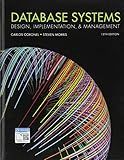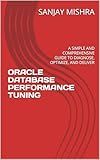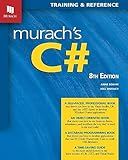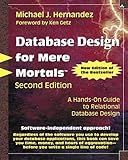Best Database Tools to Buy in December 2025

Database Systems: Design, Implementation, & Management



Identifying Wood: Accurate Results with Simple Tools
- AFFORDABLE PRICES FOR QUALITY READS WITHOUT BREAKING THE BANK.
- ECO-FRIENDLY CHOICE: KEEP BOOKS IN CIRCULATION AND REDUCE WASTE.
- THOROUGHLY INSPECTED FOR QUALITY TO ENSURE A SATISFYING PURCHASE.



The Manga Guide to Databases



Database Systems: Design, Implementation, & Management



ORACLE DATABASE PERFORMANCE TUNING: A CHECKLIST APPROACH WITH SIMPLE AND COMPREHENSIVE GUIDE TO DIAGNOSE, OPTIMIZE, AND DELIVER



Murach's C# Programming Book (8th Edition) Comprehensive Guide for Windows Forms Apps & Database Development - Self-Paced Learning for Beginners & Professional Developers



Database Design for Mere Mortals: A Hands-On Guide to Relational Database Design



Concepts of Database Management (MindTap Course List)



Data Mining: Practical Machine Learning Tools and Techniques (Morgan Kaufmann Series in Data Management Systems)
- EXCLUSIVE LAUNCH: BE AMONG THE FIRST TO EXPERIENCE OUR 'NEW' PRODUCT!
- INNOVATIVE FEATURES: TRANSFORM YOUR DAILY ROUTINE WITH CUTTING-EDGE DESIGN.
- LIMITED-TIME OFFER: SECURE YOUR 'NEW' PRODUCT AT AN INTRODUCTORY PRICE!


To generate an XML file from an Oracle SQL query, you can follow these steps:
- Connect to your Oracle database using a tool like SQL Developer or SQL*Plus.
- Write your SQL query that retrieves the data you want to include in the XML file. For example, consider a query to retrieve employee details: SELECT emp_id, emp_name, salary FROM employees;
- Using SQL*Plus or another tool, execute the SQL query.
- Use the XML functions provided by Oracle to generate XML tags and structure. Oracle provides several functions like XMLAGG, XMLELEMENT, XMLFOREST, etc., for building XML structures. SELECT XMLElement("Employee", XMLElement("EmployeeID", emp_id), XMLElement("Name", emp_name), XMLElement("Salary", salary) ) AS employee_xml FROM employees;
- Execute the updated SQL query and verify the XML structure returned.
- If you want to save the result as an XML file, you can use the SPOOL command in SQLPlus or specify an output file in SQL Developer. For example, in SQLPlus, you can use the following command to save the result in an XML file: SET PAGESIZE 0 SET COLSEP '' SET LINESIZE 1000 SET TRIMSPOOL ON SPOOL c:\path\to\file.xml -- Place your XML generation query here SPOOL OFF Replace c:\path\to\file.xml with the desired file path and name.
- Execute the entire script in SQL*Plus. The output of the query will be stored in the specified XML file.
Remember that this is a basic approach, and you may need to customize the XML structure generation based on your specific requirements.
What is the impact of XML generation on the performance of an Oracle SQL query?
The impact of XML generation on the performance of an Oracle SQL query depends on various factors, such as the complexity of the query, the volume of data being processed, and the configuration of the database server. Generally, XML generation involves transforming structured data into XML format, which can introduce additional processing overhead and potentially impact the query performance.
Here are some potential impacts of XML generation on query performance:
- Additional processing time: Converting data into XML format requires additional processing steps, such as parsing and serialization. These operations can increase the overall execution time of the query.
- CPU and memory usage: XML generation can utilize CPU and memory resources, particularly if the data being transformed is large or complex. This can lead to higher resource utilization and potentially slower query execution.
- Network transfer time: If the XML generation is performed on the database server and the resulting XML data needs to be returned to the client application, the network transfer time can be impacted. Large XML documents may take longer to transmit over the network, leading to slower query response times.
- Query optimization challenges: XML generation can sometimes complicate the optimization process of SQL queries. Oracle's query optimizer may have limitations in optimizing XML-related operations, leading to suboptimal execution plans and decreased performance.
To mitigate the impact of XML generation on query performance, it is recommended to:
- Optimize and simplify the query: Ensure that the SQL query itself is well-optimized, with appropriate indexing, join conditions, and filtering criteria. This can help minimize the impact of XML generation on the overall query performance.
- Use efficient XML generation techniques: Oracle provides various XML-related functions and features that can optimize the XML generation process. Choosing the most efficient and appropriate methods for XML generation, such as XMLType or XMLTable, can help improve performance.
- Minimize data size: Reduce unnecessary data in the generated XML, as larger XML documents require more processing and transmission time. Select only the required data elements and maintain an optimal XML structure to minimize the size of the XML generated.
- Consider offloading XML generation: If XML generation is not a critical requirement for the database server, consider offloading the XML generation to client applications or middle-tier servers. This can alleviate the processing burden on the database server and improve query performance.
Overall, the impact of XML generation on Oracle SQL query performance can vary depending on the specific scenario. It is essential to carefully evaluate the cost-benefit trade-off and consider the efficiency techniques available to achieve the best performance.
How to generate XML output from a SELECT statement in Oracle SQL?
To generate XML output from a SELECT statement in Oracle SQL, you can use the XML functions provided by Oracle.
Here's a step-by-step guide:
- Start by enabling the XML output format in SQL*Plus by executing the following command: SET SERVEROUTPUT ON FORMAT XML
- Use the XML functions in the SELECT statement to generate the XML output. The main XML functions used are XMLAGG, XMLELEMENT, and XMLFOREST. For example, let's say you have a table named 'employees' with columns 'id', 'name', and 'salary'. You can generate XML output for this table using the following SELECT statement: SELECT XMLELEMENT( "Employees", XMLAGG( XMLELEMENT( "Employee", XMLFOREST(id AS "Id", name AS "Name", salary AS "Salary") ) ) ) FROM employees; This SELECT statement creates an XML element named 'Employees' that contains multiple 'Employee' elements, each with the 'id', 'name', and 'salary' columns as attributes.
- Execute the SELECT statement. The XML output will be displayed in the SQL*Plus output window in XML format.
Note: You can also use the XMLSERIALIZE function to control the XML output format and include additional options.
How to generate XML from Oracle SQL query using XSL transformation?
To generate XML from an Oracle SQL query using XSL transformation, you can follow these steps:
- Create a SQL query that retrieves the data you want to convert to XML. For example:
SELECT emp_id, emp_name, emp_salary FROM employees
- Use Oracle's XML functions to convert the query result into XML format. For example:
SELECT XMLElement("employee", XMLForest(emp_id as "id", emp_name as "name", emp_salary as "salary")) FROM employees
- Wrap the SQL query in a XSLT transformation to format the XML output as desired. Create an XSLT template file, for example, "query_to_xml.xsl", with the following content:
<xsl:stylesheet version="1.0" xmlns:xsl="http://www.w3.org/1999/XSL/Transform"> <xsl:output method="xml" indent="yes"/>
<xsl:template match="/"> <xsl:for-each select="/ROWSET/employee"> <xsl:value-of select="id"/> <xsl:value-of select="name"/> <xsl:value-of select="salary"/> </xsl:for-each> </xsl:template> </xsl:stylesheet>
- Use Oracle's XMLTRANSFORM function to apply the XSLT transformation to the XML result. For example:
SELECT XMLTransform(XMLQuery('' ||(SELECT XMLElement("employee", XMLForest(emp_id as "id", emp_name as "name", emp_salary as "salary")) FROM employees) ||''), 'query_to_xml.xsl') as xml_output FROM dual;
The SQL query will return the XML formatted result with the XSLT transformation applied. You can modify the XSLT template as needed to match your desired XML output structure.
How can I create XML output from an Oracle SQL query?
To create XML output from an Oracle SQL query, you can use the XML functions and features provided by Oracle. Follow these steps:
- Identify the data you want to include in the XML output and write a SQL query to retrieve that data. For example: SELECT column1, column2, column3 FROM table WHERE condition;
- Use the XML functions to format the result set as XML data. Oracle provides several XML functions like XMLRoot, XMLAgg, XMLElement, etc., which you can use to generate XML data from the query result set. For example: SELECT XMLElement("row", XMLForest(column1 AS "column1", column2 AS "column2", column3 AS "column3")) FROM table WHERE condition;
- If required, use additional XML functions to further enhance the XML output. For instance, you can use XMLRoot to add a root element to the XML output, or XMLAgg to aggregate multiple XML nodes. For example: SELECT XMLRoot(XMLAgg(XMLElement("row", XMLForest(column1 AS "column1", column2 AS "column2", column3 AS "column3"))), XMLFormatPreserve()) FROM table WHERE condition;
- Execute the query to generate the XML output. The result will be a single column with XML data.
Note: The specific XML functions and syntax may vary depending on the version and edition of Oracle you are using. Consult the Oracle documentation for the version you are working with for more details on XML functions and features.
What are the steps to generate an XML file using Oracle SQL?
To generate an XML file using Oracle SQL, you can follow the steps below:
- Write a SQL query that retrieves the necessary data and formats it in XML format using the XML functions and clauses provided by Oracle. For example: SELECT XMLELEMENT("Root", XMLAGG( XMLELEMENT("Node", XMLFOREST(column1 AS "Column1", column2 AS "Column2") ) ) ).getClobVal() AS xml_data FROM your_table This query creates an XML structure with root element "Root" and child node "Node" for each row in the table, using the XMLFOREST and XMLELEMENT functions.
- Execute the SQL query to retrieve the XML data. In Oracle SQL Developer or any other Oracle SQL tool, you can run the query by executing it.
- Depending on your SQL tool, you may need to export the result of the query as a file. For example, in Oracle SQL Developer, you can right-click on the query result, select "Export", and choose a file format like CSV or XML. If your SQL tool doesn't have an export feature, you can save the XML data as a CLOB (Character Large Object) in a temporary table and then use PL/SQL to write the XML data to a file using the UTL_FILE package.
- Save the exported XML file to your desired location.
Note: Ensure that you have the necessary permissions and privileges to execute SQL queries, access the required tables, and write files on the database server.
What is the role of XMLgen in generating XML from an Oracle SQL query?
XMLgen is a function in Oracle Database that allows users to generate XML output from an SQL query result. It takes an SQL query as input and converts the result set into an XML format.
The role of XMLgen is to provide a mechanism to generate XML data from structured data stored in Oracle tables or retrieved using SQL queries. It helps in converting the relational data into a hierarchical XML structure, which can be easily consumed by other applications, web services, or for data exchange purposes.
By using XMLgen, users can customize the XML output according to their requirements. They can specify the structure of the XML document, define the layout, and define the data to be included using SQL queries. XMLgen also supports various XML features such as namespaces, encoding, formatting, and schema-based validation.
Overall, the primary role of XMLgen is to facilitate the transformation of Oracle SQL query results into XML format, enabling the seamless integration and interoperability between different systems and applications.
